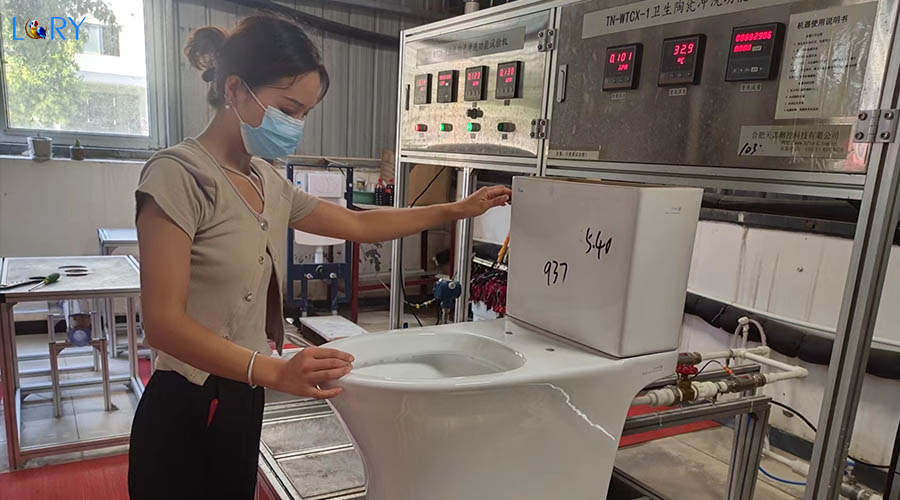Toilets are an essential fixture in any building or household. They are responsible for maintaining proper sanitation and hygiene, and thus it is imperative that they function efficiently and effectively. To ensure that the toilets meet the required standards, it is essential to conduct various tests before they are shipped out of the factory. These tests ensure that the toilets meet the quality and safety requirements and are fit for use. This article discusses the various tests that need to be performed on toilets before they are shipped out of the factory, and why they are essential.

The tests that need to be performed on toilets before they are shipped out of the factory are as follows:
1. Water Pressure Test: The water pressure test is conducted to check the structural integrity of the toilet bowl and tank. The toilet bowl and tank are filled with water, and pressure is applied to the interior of the bowl and tank. The pressure is then released, and the toilet is inspected for leaks or cracks. This test is conducted to ensure that the toilet can withstand the normal water pressure that it will be subjected to during use.
2. Flush Performance Test: The flush performance test is conducted to check the efficiency of the toilet’s flushing mechanism. The toilet is filled with a specific amount of water, and a certain amount of waste material is introduced into the bowl. The toilet is then flushed, and the amount of waste material that is removed is measured. This test ensures that the toilet can remove waste effectively and efficiently.
3. Leak Test: The leak test is conducted to check for any leaks in the toilet’s tank and bowl. The toilet is filled with water, and dye is added to the water. The toilet is then left for a specific amount of time, and if any dye is visible outside the toilet, it indicates a leak. This test ensures that the toilet is watertight and will not leak during use.
4. Seat Durability Test: The seat durability test is conducted to check the strength and durability of the toilet seat. The seat is subjected to a certain amount of weight for a specific amount of time, and then inspected for any signs of damage. This test ensures that the seat can withstand the weight of the user and will not break or crack during use.

5. Chemical Resistance Test: The chemical resistance test is conducted to check if the toilet is resistant to different chemicals. The toilet is exposed to different chemicals for a specific amount of time, and then inspected for any signs of damage or discoloration. This test ensures that the toilet can withstand the effects of different chemicals, such as cleaning agents, that may be used during cleaning.
6. Temperature Resistance Test: The temperature resistance test is conducted to check if the toilet can withstand extreme temperatures. The toilet is exposed to different temperatures, both hot and cold, for a specific amount of time, and then inspected for any signs of damage or deformation. This test ensures that the toilet can withstand extreme temperatures that may be encountered during use or cleaning.
7. Impact Resistance Test: The impact resistance test is conducted to check if the toilet can withstand impact or force. The toilet is subjected to a specific amount of force, and then inspected for any signs of damage or deformation. This test ensures that the toilet can withstand accidental impacts or force that may be encountered during use.
Why are these tests important?
The tests that are conducted on toilets before they are shipped out of the factory are essential for several reasons:
1. Quality Control: The tests ensure that the toilets meet the required quality standards. The tests are conducted to ensure that the toilets are structurally sound, function efficiently, and are resistant to various chemicals and temperatures.

2. Safety: The tests ensure that the toilets are safe for use. The tests ensure that the toilets are watertight and will not leak, can withstand the weight of the user,and can withstand accidental impacts or force that may be encountered during use. This ensures that the users are not at risk of injury or harm while using the toilet.
3. Customer Satisfaction: The tests ensure that the toilets meet the customers’ expectations in terms of quality and performance. If the toilets are found to be faulty or defective during the tests, they can be corrected before they are shipped out of the factory, ensuring that the customers receive a high-quality product that meets their requirements.
4. Compliance: The tests ensure that the toilets comply with the relevant regulations and standards. The tests ensure that the toilets meet the required safety and performance standards set by regulatory bodies, such as the American Society of Mechanical Engineers (ASME), the International Plumbing Code (IPC), and the Uniform Plumbing Code (UPC).
5. Cost Savings: The tests ensure that the toilets are of high quality and are resistant to various chemicals and temperatures. This reduces the likelihood of the toilets being returned due to defects or damage, which can be costly for the manufacturer.
Conclusion:
In conclusion, toilets are an essential fixture in any building or household, and it is imperative that they function efficiently and effectively. To ensure that the toilets meet the required quality and safety standards, various tests need to be conducted before they are shipped out of the factory. These tests ensure that the toilets are structurally sound, function efficiently, and are resistant to various chemicals and temperatures. They also ensure that the toilets are safe for use, meet the customers’ expectations, comply with the relevant regulations and standards, and can result in cost savings for the manufacturer. Therefore, it is essential that these tests are conducted before the toilets are shipped out of the factory.